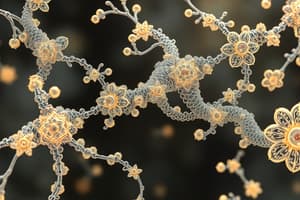Podcast
Questions and Answers
What is the primary role of the 3'-OH group during RNA synthesis?
What is the primary role of the 3'-OH group during RNA synthesis?
- To stabilize the RNA molecule
- To initiate transcription
- To react with the 5'-P group of another ribonucleotide (correct)
- To terminate transcription
Which statement accurately describes the structure of the RNA polymerase holoenzyme?
Which statement accurately describes the structure of the RNA polymerase holoenzyme?
- Consists of two α polypeptides and the β, β', and σ subunits (correct)
- Has a molecular mass less than the core enzyme
- Is formed only during RNA termination
- Contains only one type of polypeptide
What differentiates the core RNA polymerase enzyme from the holoenzyme?
What differentiates the core RNA polymerase enzyme from the holoenzyme?
- The core enzyme lacks the α subunit (correct)
- The holoenzyme functions exclusively in termination
- The core enzyme contains the σ subunit
- The core enzyme is smaller in molecular mass
Approximately how many RNA polymerase molecules are actively involved in transcription at a given time in an E. coli cell?
Approximately how many RNA polymerase molecules are actively involved in transcription at a given time in an E. coli cell?
What aspect of RNA synthesis does the presence of the DNA template influence?
What aspect of RNA synthesis does the presence of the DNA template influence?
Study Notes
RNA Synthesis
- RNA synthesis is the process of creating an RNA molecule from ribonucleotide subunits.
- The reaction involves the polymerisation of ribonucleotides, where the 3'-OH group of one ribonucleotide reacts with the 5'-P group of another, forming a phosphodiester bond.
- This process is guided by a DNA template, which dictates the order of ribonucleotides in the newly synthesized RNA molecule.
- DNA-dependent RNA polymerase is the enzyme responsible for catalyzing this reaction.
DNA-dependent RNA Polymerase
- The enzyme responsible for RNA synthesis in E.coli was discovered in 1958.
- Each E.coli cell contains approximately 7000 RNA polymerase molecules, with 2000 to 5000 actively involved in transcription at any given time.
- The structure of the enzyme is α₂ββ' σ, meaning it comprises two α polypeptides, one β, one β', and one σ subunit.
- This complete enzyme is referred to as the holoenzyme, with a molecular mass of 450,000 daltons.
- The core enzyme, lacking the σ subunit, has a molecular mass of 380,000 daltons.
- The holoenzyme and core enzyme have distinct roles during transcription.
Studying That Suits You
Use AI to generate personalized quizzes and flashcards to suit your learning preferences.
Description
This quiz explores the essential process of RNA synthesis, highlighting the role of ribonucleotides, DNA templates, and the enzyme DNA-dependent RNA polymerase. You will also learn about the structure and function of this enzyme, particularly in E.coli, where it plays a crucial role in transcription.




